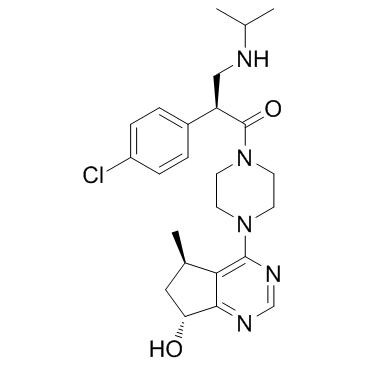GDC-0068
Modify Date: 2024-01-02 21:09:47

GDC-0068 structure
|
Common Name | GDC-0068 | ||
|---|---|---|---|---|
| CAS Number | 1001264-89-6 | Molecular Weight | 457.996 | |
| Density | 1.3±0.1 g/cm3 | Boiling Point | 669.4±55.0 °C at 760 mmHg | |
| Molecular Formula | C24H32ClN5O2 | Melting Point | N/A | |
| MSDS | N/A | Flash Point | 358.7±31.5 °C | |
Use of GDC-0068Ipatasertib (GDC-0068) is a highly selective and ATP-competitive pan-Akt inhibitor with IC50s of 5, 18 and 8 nM for Akt1, Akt2 and Akt3, respectively. |
| Name | (2S)-2-(4-chlorophenyl)-1-[4-[(5R,7R)-7-hydroxy-5-methyl-6,7-dihydro-5H-cyclopenta[d]pyrimidin-4-yl]piperazin-1-yl]-3-(propan-2-ylamino)propan-1-one |
|---|---|
| Synonym | More Synonyms |
| Description | Ipatasertib (GDC-0068) is a highly selective and ATP-competitive pan-Akt inhibitor with IC50s of 5, 18 and 8 nM for Akt1, Akt2 and Akt3, respectively. |
|---|---|
| Related Catalog | |
| Target |
Akt1:5 nM (IC50) Akt2:18 nM (IC50) Akt3:8 nM (IC50) PKA:3100 nM (IC50) |
| In Vitro | Ipatasertib (GDC-0068) shows more than 600 and more than 100-fold selectivity for Akt1 in IC50 against the closely related kinases PKA and p70S6K, respectively. When tested at 1 μM in a panel of 230 protein kinases, which includes 36 human AGC family members, GDC-0068 inhibits only 3 other kinases by more than 70% at 1 μM concentration (PRKG1α, PRKG1β, and p70S6K). IC50s measured for these 3 kinases are 98, 69, and 860 nM, respectively. Thus, with the exception of PKG1 (relative to which Ipatasertib (GDC-0068) is >10-fold more selective for Akt1), Ipatasertib (GDC-0068) displays a more than 100-fold selectivity for Akt1 over the next most potently inhibited non-Akt kinase, p70S6K, in the screening kinase panel. The relationship between pharmacokinetics (PK) and pharmacodynamics (PD) of Ipatasertib (GDC-0068) is investigated in 3 xenograft models that showed dose-dependent response to drug treatment: MCF7-neo/HER2, TOV-21G.x1, and LNCaP. The mean cell viability IC50 of GDC-0068 in these 3 cell lines is 2.56, 0.44, and 0.11 μM, respectively[2]. |
| In Vivo | Ipatasertib (GDC-0068) is typically efficacious in xenograft models in which Akt is activated because of genetic alterations including PTEN loss, PIK3CA mutations/amplifications, or HER2 overexpression. In these models, tumor growth delay, stasis, or regression is achieved at or below 100 mg/kg daily oral dose, which is the maximum dose tested in immunocompromised mice that is well tolerated. When tested in vivo, daily dosing of Ipatasertib (GDC-0068) in combination with Docetaxel induces tumor regression and stasis in the PC-3 and MCF7-neo/HER2 xenograft models, at doses where each single agent is ineffective or only causes modest tumor growth delay. Similarly, increased TGI is observed in the OVCAR3 ovarian cancer xenograft model when Ipatasertib (GDC-0068) is combined with Carboplatin. The combination of Ipatasertib (GDC-0068) with Docetaxel or Carboplatin is tolerated with less than 5% body weight loss when compared with treatment with each chemotherapeutic agent alone[2]. |
| Cell Assay | The 384-well plates are seeded with 2,000 cells per well in a volume of 54 μL per well followed by incubation at 37°C under 5% CO2 overnight (~16 hours). Compounds (e.g., Ipatasertib (GDC-0068)) are diluted in DMSO to generate the desired stock concentrations then added in a volume of 6 μL per well. All treatments are tested in quadruplicates. After 4 days incubation, relative numbers of viable cells are estimated using CellTiter-Glo and total luminescence is measured on a Wallac Multilabel Reader. The concentration of drug resulting in IC50 is calculated from a 4-parameter curve analysis (XLfit) and is determined from a minimum of 3 experiments. For cell lines that failed to achieve an IC50, the highest concentration tested (10 μM) is listed[2]. |
| Animal Admin | Mice[2] In vivo efficacy is evaluated in multiple tumor cell line- and patient-derived xenograft models. Cells or tumor fragments are implanted subcutaneously into the flank of immunocompromised mice. Female or male nude (nu/nu) or severe combined immunodeficient mice (SCID)/beige mice are used. For the MCF7-neo/HER2 model, 17β-estradiol pellets (0.36 mg/pellet, 60-day release) are implanted into the dorsal shoulder before cell inoculation. The LuCaP35V patient-derived primary tumors are obtained; male mice are castrated before implantation of tumor fragments. After implantation of tumor cells or fragments into mice, tumors are monitored until they reached mean tumor volumes of 180 to 350 mm3 and distributed into groups of 8 to 10 animals/group. Ipatasertib (GDC-0068) is formulated in 0.5% methylcellulose/0.2% Tween-80 (MCT) and administered daily (QD), via oral (per os; PO) gavage. Docetaxel is formulated in 3% EtOH/97% saline and dosed intravenously (IV) every week (QW) at 2.5 or 7.5 mg/kg. Carboplatin is formulated in saline and dosed intraperitoneally (IP) weekly at 50 mg/kg. |
| References |
| Density | 1.3±0.1 g/cm3 |
|---|---|
| Boiling Point | 669.4±55.0 °C at 760 mmHg |
| Molecular Formula | C24H32ClN5O2 |
| Molecular Weight | 457.996 |
| Flash Point | 358.7±31.5 °C |
| Exact Mass | 457.224457 |
| PSA | 81.59000 |
| LogP | 1.71 |
| Vapour Pressure | 0.0±2.1 mmHg at 25°C |
| Index of Refraction | 1.603 |
| Storage condition | -20℃ |
| Water Solubility | Soluble in DMSO. |
| RG7440 |
| (S)-2-(4-chlorophenyl)-1-(4-((5R,7R)-7-hydroxy-5-methyl-6,7-dihydro-5H-cyclopenta[d]pyrimidin-4-yl)piperazin-1-yl)-3-(isopropylamino)propan-1-one |
| 1-Propanone, 2-(4-chlorophenyl)-1-[4-[(5R,7R)-6,7-dihydro-7-hydroxy-5-methyl-5H-cyclopenta[d]pyrimidin-4-yl]-1-piperazinyl]-3-[(1-methylethyl)amino]-, (2S)- |
| GDC 0068 |
| cc-616 |
| RG 7440 |
| GDC-0068 |
| Ipatasertib |
| (2S)-2-(4-Chlorophenyl)-1-{4-[(5R,7R)-7-hydroxy-5-methyl-6,7-dihydro-5H-cyclopenta[d]pyrimidin-4-yl]-1-piperazinyl}-3-(isopropylamino)-1-propanone |